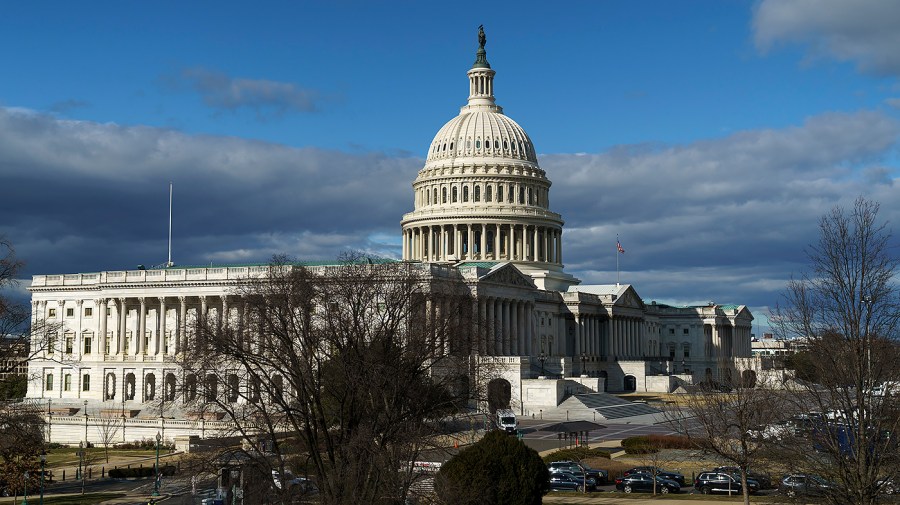Breaking down Biden’s budget: Here’s what’s in it
President Biden on Thursday unveiled a sweeping budget plan for the coming fiscal year.
The request details a set of ambitious proposals from the White House, ranging from plans to extend the lifetime of programs like Medicare, tax proposals targeting the wealthy to help reduce the deficit by trillions of dollars over the next decade, and funding for a slew of Democratic priorities.
Budget requests typically do not become law, and Biden’s will be no exception, with the House controlled by Republicans and Democrats holding a narrow majority in the Senate.
But the request will serve as an important point in the debates this year on raising the debt ceiling and funding the government.
Here’s what Biden has proposed.
Defense-nondefense

The newly revealed budget calls for increasing the Department of Defense’s budget by 3.2 percent from the previous year. (AP Photo/Patrick Semansky, File)
The budget request calls for raising the discretionary budget authority for the Department of Defense to $842 billion for fiscal 2024, up 3.2 percent from the previous year.
A chart breaking down the discretionary funding requests by agency outlined a top-line request of more than $886 billion in base discretionary funding for defense programs for fiscal 2024, or a 3.3 percent boost from policies enacted in 2023.
Democrats are already expecting Republicans to press for a higher amount, as Senate Minority Leader Mitch McConnell (R-Ky.) has pushed for “substantial defense increases” on the defense side for the coming fiscal year.
However, it’s unclear how defense spending will factor into ongoing discussions among House Republicans aimed at securing reforms to curb government spending, as both sides clash over how to address the nation’s debt limit.
The plan also included a request for $688 billion in base discretionary funding for nondefense programs, up 7.3 percent from the previous fiscal year, as well a proposed $121 billion in Veterans Affairs Medical Care Program funding.
The White House also pressed on the matter of parity between the proposed levels of growth for defense and nondefense spending — which is often the source of conflict in bipartisan spending talks — during a press call ahead of the release of the proposal on Wednesday.
“We’re talking about two different bases we can absolutely talk about … whether there should be parity with defense is $886 billion,” Office of Management and Budget Director Shalanda Young said. “We think that’s the right level to be at for defense programs because we are basing and building that program from requirements. What is our national defense strategy? And we’re investing responsibly while reducing the deficit.”
Tax increases

Biden’s budget proposes a “billionaire” minimum tax, as well as a corporate tax rate raise. (AP Photo/Evan Vucci)
Biden is going big on taxes, targeting wealthier Americans to pay for roughly $3 trillion in deficit reduction over the next decade.
He is proposing a “billionaire” minimum tax, which would impose a tax of at least 25 percent on total income for Americans whose wealth exceeds $100 million. He also is proposing raising the corporate tax rate from 21 percent to 28 percent. Biden would also raise the tax rate on U.S. multinationals’ foreign earnings and quadruple the stock buybacks tax.
Such proposals have already been met with fierce opposition from Republicans and are unlikely to make it past a GOP-led House, laying the groundwork for another partisan battle over taxes on Capitol Hill.
Biden is not proposing any tax hikes on households making less than $400,0000, reflecting a position from his campaign.
Entitlements

The president has teased a plan to bolster Social Security, but the budget does not include a plan to strengthen solvency for the program. (iStock)
The president already previewed a plan to extend the lifetime of Medicare, as the program’s Hospital Insurance fund is projected to become insolvent in less than a decade.
The plan seeks to lengthen solvency into the 2050s, as well as other proposed measures to lower costs for beneficiaries, by imposing a higher tax rate “on earned and unearned income above $400,000.”
Biden also teased a pitch to “strengthen” Social Security, which is projected to reach insolvency by 2032, but aside from opposing attempts to “cut Social Security benefits” in the request, the administration’s proposal appears to fall short of providing a plan to shore up solvency for the program.
The plan instead included a 10 percent spending boost for the Social Security Administration, or $1.4 billion, while pushing for investments in “service delivery to speed up claims processing” and ensure recipients receive promised benefits.
“The administration looks forward to working with the Congress to responsibly strengthen Social Security by ensuring that high-income individuals pay their fair share,” the White House also said in an accompanying fact sheet.
The statement comes as a bipartisan group of senators has drawn attention in recent weeks as they explore potential solutions to address the solvency threat facing Social Security.
Child tax credit

Democrats have called for the Child Tax Credit to be renewed since it expired at the end of 2021. (Greg Nash)
Biden wants to restore the full child tax credit, which was first enacted in the American Rescue Plan that passed early in his administration. The budget would expand the credit from $2,000 per child to $3,000 per child for children six years old and above, and to $3,600 per child for children under six.
Democrats have called for a renewal of the expanded child tax credit since it expired at the end of 2021 and have championed the popular tax break. Biden’s budget would permanently reform the credit to make it fully refundable.
Biden also called on Congress to make the earned-income tax credit expansion for childless workers permanent.
Ukraine and China

Biden’s budget requests $753 million to continue supporting Ukraine in the war with Russia. (AP Photo/Evgeniy Maloletka)
The budget includes continued support for Ukraine amid the war with Russia, as well as investments to outcompete China.
The budget requests $753 million for Ukraine to continue to counter Russia’s invasion and more than $6 billion overall to support Ukraine, as well as the U.S. alliance with NATO and other European allies.
To prioritize China in the national defense strategy, the budget highlights $9.1 billion of targeted investments that the Defense Department can make to bolster the capacity and capabilities of U.S. allies and partners in the Indo-Pacific region.
Biden wants to strengthen the U.S. role in the Indo-Pacific by investing $2 billion to create a new International Infrastructure Fund, $2 billion to create a new equity revolving fund to support equity investments, and $2 billion to make investments in the Indo-Pacific to strengthen partner economies.
Border security

The proposal includes an increase for CPB from the $15.3 billion Biden proposed in his 2023 budget. (AP Photo/Eric Gay, File)
The budget includes funds for Customs and Border Patrol to hire an additional 350 Border Patrol Agents, $535 million for border technology at and between ports of entry, $40 million to combat fentanyl trafficking and disrupt transnational criminal organizations and funds to hire an additional 460 processing assistants at Customs and Border Protection, as well as Immigration and Customs Enforcement.
The proposal is an increase from the $15.3 billion Biden proposed for Customs and Border Protection in his fiscal 2023 budget, and it comes at a time when Republicans are using their new House majority to put a spotlight on the U.S.-Mexico border.
Copyright 2023 Nexstar Media Inc. All rights reserved. This material may not be published, broadcast, rewritten, or redistributed. Regular the hill posts







